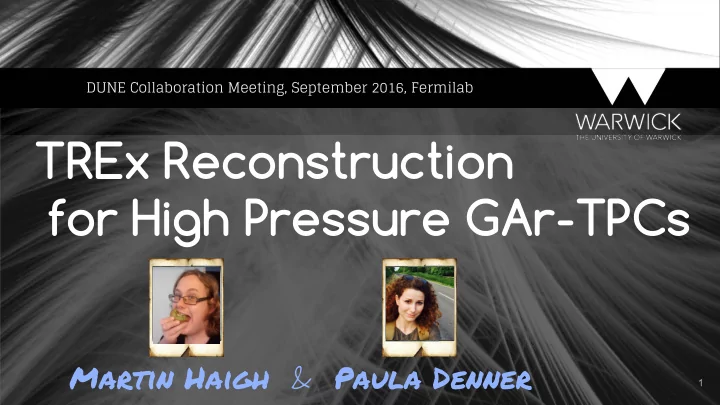

DUNE Collaboration Meeting, September 2016, Fermilab TREx Reconstruction for High Pressure GAr-TPCs Martin Haigh & Paula Denner 1
TREx for T2K ● TREx was developed to cope with reconstructing vertices in the 3 large Argon-Gas TPCs in ND280 => needs to be fully 3D (no assumptions about forward going tracks or vertex position -> Homogeneity & Isotropy ) => As physics-agnostic as possible: Lets analysers Gas Interaction in ND280. decide whether something is a vertex or a T2K Argonuts Group secondary interaction. => Good reconstruction of delta-rays (distinguishing tightly curled/curved track from sharp kinks (potential nu-interaction) 2 2
TREx for T2K - why did we need it? We want to Reconstruct Gas Interactions! OLD RECON: more standard TREx: bespoke Pattern Recognition reconstruction using RECPACK 3
TREx for T2K - why did we need it? TREx has been shown to outperform old reconstruction and to provide better overall cleanliness, completeness and purity, especially due to careful handling of δ-rays and backward going tracks. 1 First step of Pattern Recognition: Edge detection 4
Pattern Recognition Path finding by Eddy Larkin, Warwick 2 TREx uses the A* Algorithm for pathfinding ● Paths are formed according to connection cost factors between pattern Junction finding edges. 3 Diverging paths are used to identify junctions. Kink finding ● 4 ● Kink-finding can distinguish V-like two-track patterns from single curved tracks TREx tutorial: http://www.t2k.org/nd280/physics/xsec/subgroup/TPCInteractions/meetings/gas-interactions-2016-06-17/eddy-patr 5 5 ec-tutorial-2016-17-06/view
TREx for DUNE ● Warwick Group is making an effort to use pre-existing recon expertise from T2K (Eddy Larkin from Warwick and others) and isolate the TREx package from nd280 software. Right now the entire pattern recognition code lives in a GitHub repository that we develop. ○ Should discuss how to use this code in conjunction with GArSoft and put documentation on Redmine Schematics of a Pressure Vessel ● For 4th run-through it should be possible to provide the task force with reconstructed input for sensitivity studies. 6 6
TREx for DUNE Why do we think a good Pattern Recognition is important for DUNE ND? An often mentioned weakness of HPTPC vs. the other designs is large backgrounds from heavy materials in the Magnet and the ECals. Reconstructing genuine gas interaction vertices in the presence of such backgrounds is paramount! Also need accurate track-matching with the ECal. 7
TREx at work Do we think TREx is up to the task? Gas interaction with a cleanly reconstructed vertex and correctly associated tracks in a high background event: Input are G4-simulated Hits with voxelisation of 1x1x1cm 8 8
Inputs to TREx What does TREx need from you to work its pattern recognition magic? ● At the moment we have a thin and simple interface that accepts a 3D TSparse root histogram with the coordinates being the hit position and the bin content being the energy deposition ● We are in the process of redefining our input requirements to stay in sync with the Liverpool Group’s simulation. Will probably move from TSparse to a proper voxel object. 9
TREx Output ● Running the pattern recognition on the voxelised inputs forms PATHS (proto-Tracks) and JUNCTIONS (proto-Vertices) which constitute the output. The executable makes a “ TPCRecon” Tree with the pattern information to the input file. Can visualise the output and the preliminary results look very promising, but more fitting procedures are needed to make pattern information quantitatively useful. 10
Watch this Space! The Future NEXT: Include Track Fitting and Track Merging with likelihood fitter to recover tracks broken by δ-rays (!) high priority ● We have moved beyond implementing the pattern recognition part of TREx and are now learning about and rewriting higher level code for fitting our patterns. ○ How do people feel about RecPack dependencies? Post-Production: Start making performance plots and test out how robust Pattern Recognition is when dealing with lower resolutions 11
Recommend
More recommend